Spargel, mehlige Kartoffeln, Lauch, Möhren, Gurke, Rhabarber, Kopfsalat, Bärlauch, Eier und ein Bio-Huhn
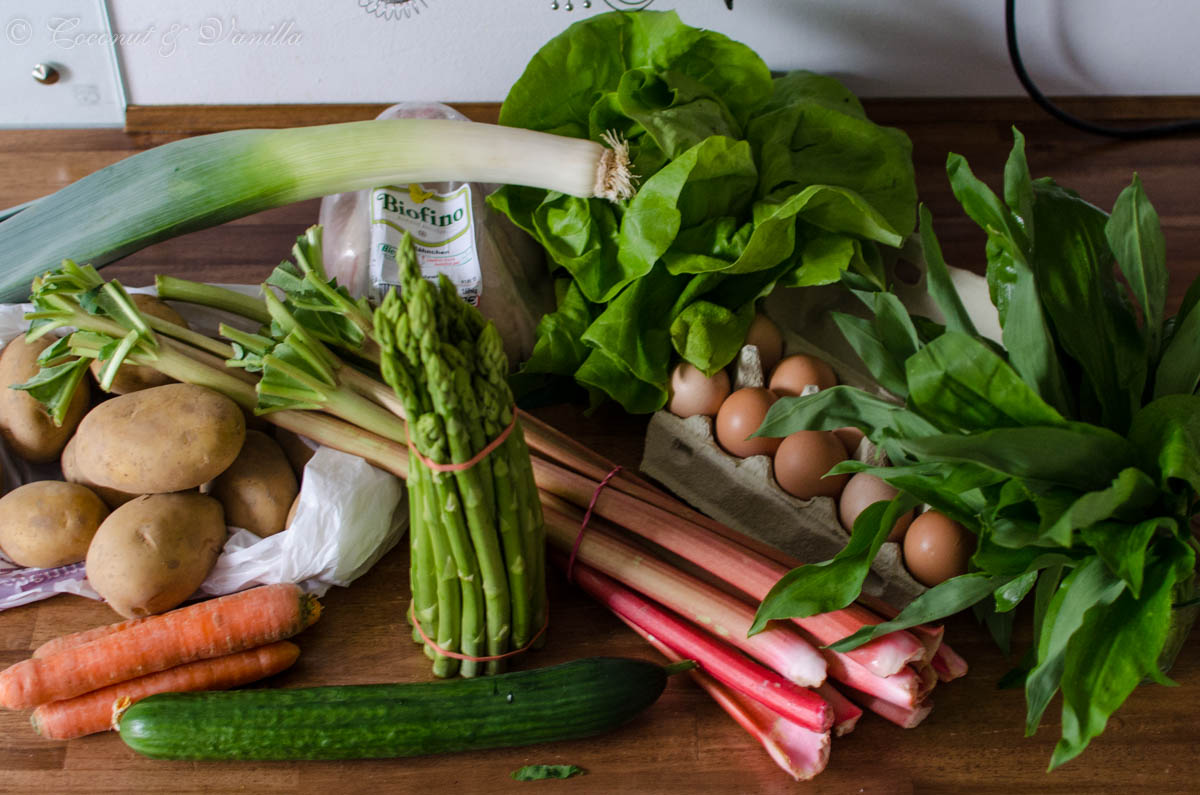
asparagus, russet potatoes, leeks, carrots, cucumber, rhubarb, lettuce, wild garlic, eggs and an organic chicken

Coconut & Vanilla
Spargel, mehlige Kartoffeln, Lauch, Möhren, Gurke, Rhabarber, Kopfsalat, Bärlauch, Eier und ein Bio-Huhn

asparagus, russet potatoes, leeks, carrots, cucumber, rhubarb, lettuce, wild garlic, eggs and an organic chicken

Der Frühling lässt sich endlich blicken! Und das merkt man nicht nur am Wetter, sondern auch am Rhabarber und Bärlauch auf dem Wochenmarkt. Sogar deutschen Spargel habe ich schon gesichtet, aber der ist zur Zeit noch gscheid teuer.
Bärlauch und Rhabarber wanderten also gleich in unseren Einkaufkorb. Rhabarberrezepte habe ich schon viele auf dem Blog (hier, hier, hier, hier und hier), aber kein einziges Bärlauchrezept! Gibt’s doch gar nicht! Nach kurzer Suche bin ich bei Juliane von Schöner Tag noch! hängen geblieben. Juliane hat eine riesengroße Sammlung an Bärlauchrezepten auf ihrem Blog und dieses hier habe ich mir unter anderem rausgepickt.
Eine Tarte mit Bärlauch ist ja auch mal was anderes und mit den ersten Tomaten des Jahres verfeinert hat sie mich gleich überzeugt. Sehr sehr köstlich und einfach passend zum Frühling!

Vor einem Jahr: Orangettes
Vor zwei Jahren: French Toast oder Arme Ritter
Vor drei Jahren: Rhabarber-Streusel-Kuchen
Bärlauch-Tomaten-Tarte
angelehnt an ein Rezept von Schöner Tag noch!
Zutaten:
Eine Tarteform mit hohem Rand oder eine Springform (28 cm Durchmesser) ausfetten.
Butter, Mehl, 1/2 TL Salz in der Küchenmaschine verrühren. Wenn die Butter die Größe von Erbsen hat das Ei hinzufügen und alles verkneten. Eventuell 1-2 EL kaltes Wasser hinzufügen, falls der Teig zu trocken ist. Wer keine Küchenmaschine hat kann den Teig auch mit den Händen zusammenbringen.
Den Teig ausrollen und die Tarte- bzw. Springform damit auslegen und einen Rand hochziehen.
Die Form 30 Minuten in den Kühlschrank stellen.
Den Ofen auf 200° C (Umluft 180°C) vorheizen.
Den Bärlauch waschen, trocken schleudern und grob hacken.
Milch, Crème fraîche und die Eier verquirlen. Den Parmesan und den Bärlauch unterühren. Kräftig mit Muskat, Salz und Pfeffer abschmecken.
Die Tomaten waschen, halbieren und den Strunk entfernen. Die Tomatenhälften vierteln.
Die Bärlauchcreme in die Form füllen und mit den Tomatenstücken belegen.
Die Tarte in 40 Minuten goldgelb backen.
Finally you can see spring! And we do not only notice because of the better weather, but because there’s rhubarb and wild garlic on the farmer’s market. I’ve already spotted some German asparagus, but it’s still really pricey, so I will wait.
But we bought the wild garlic and rhubarb, of course. I have already a lot of rhubarb recipes on my blog (here, here, here, here and here), but not a single recipe with wild garlic! What a shame! After a quick search I got caught on Julianes blog Schöner Tag noch!. Juliane has a huge collection of wild garlic recipes on her blog and I picked this one amongst others to cook.
A tart with wild garlic is quite something special and with the first tomatoes of the season it convinced me straight away. Very delicious and so perfect for spring!

One year ago: orangettes
Two years ago: french toast
Three years ago: rhubarb streusel cake
Wild Garlic and Tomato Tarte
adapted from Schöner Tag noch!
Ingredients:
Butter a tart pan with high rim or a spring pan (28 cm in diameter).
Add the butter, flour and 1/2 tsp of salt to a food processor and pulse until the butter has the size of small peas. Alternatively use your stand mixer and the paddle attachement. Add the egg and knead, until it all comes together. Add 1-2 Tbsp cold water, if the dough is too dry. If you don’t own any of these electric machines, knead the dough by hand.
Roll out the dough and line your tart or springform pan with it and form a rim.
Place the pan for 30 minutes in the fridge.
Preheat the oven to 200° C.
Rinse the wild garlic and spin it dry. Chop it coarsely.
Whisk milk, crème fraîche and eggs together. Stir in the parmesan and the chopped wild garlic. Season generously with salt, pepper and nutmeg.
Rinse the tomatoes. Half them and remove the core. Quarter the halves.
Pour the wild garlic cream into the pan and place the tomato eights on the cream.
Bake for 40 minutes until golden.
Sahne,Brunnenkresse, Feldsalat, Rucola, Bärlauch, Rhabarber, Blumenkohl, Lauch, Sellerie, Tomaten, Möhren, Petersilie, Rosmarin und Käse
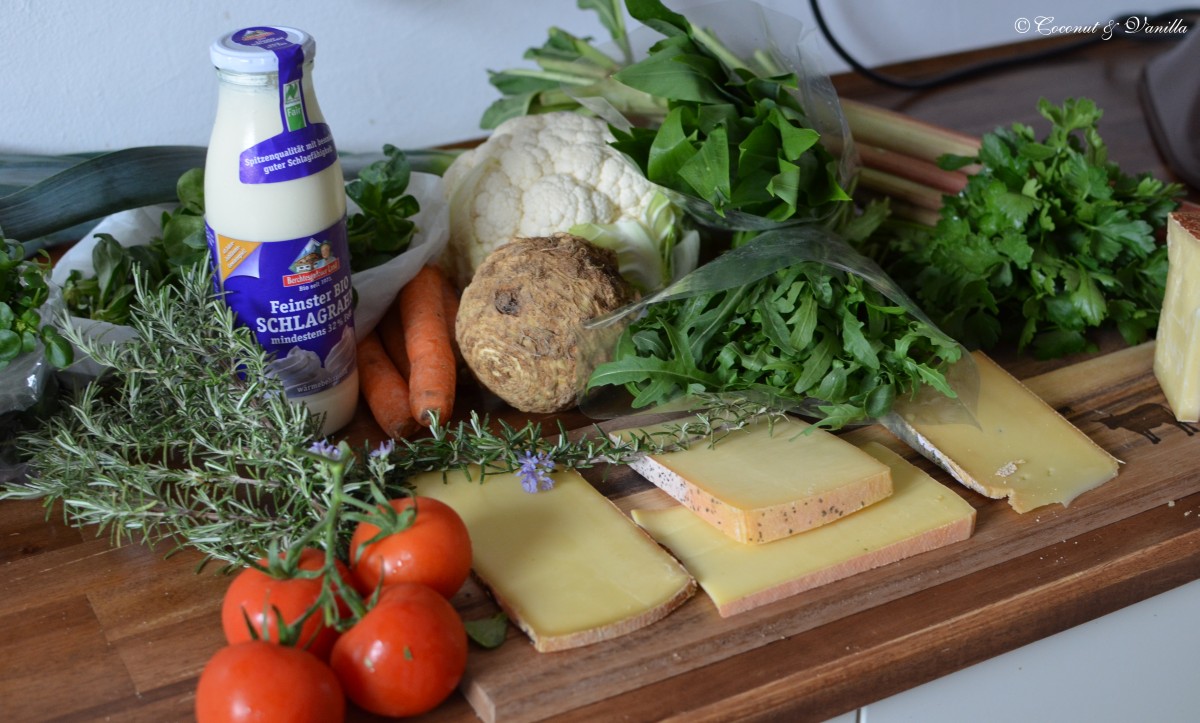
whipping cream, watercress, lettuce, arugula, wild garlic, rhubarb, cauliflower, leeks, celeriac, tomatoes, carrots, parsley, rosemary and cheese

Irgendwann muss es ja mal raus: Wir sind große Cocktailliebhaber und -trinker! Wir setzen uns gerne auch mal in eine Bar dazu, aber da uns das außerhalb der Happy Hour dann doch zu teuer ist für ein bisschen Saft und einen Schuss Alkohol machen wir die Cocktails gerne selbst. Das ein oder andere Cocktailbuch findet sich also auch bei mir zwischen den vielen Kochbüchern. Nun braucht man zum Cocktailmixen doch einige Grundzutaten daheim, sonst gibt man schnell wieder frustriert auf.
So ist es hilfreich einen kleinen Vorrat an Saft zu haben. Mit Orangensaft, Ananassaft, sowie Zitronensaft und Limettensaft kommt man fast immer ans Ziel. Zitronen- und Limettensaft gibt es auch in der Flasche und die halten auch geöffnet im Kühlschrank sehr lange.
Dann kommen Sirups bzw. Liköre. Ich versuche einiges davon selbst herzustellen, denn wenn ich auf die Zutaten von vielen Sirups oder Likören schaue wird mir schlecht. Viele haben die Frucht höchstens mal aus der Entfernung gesehen und bestehen nur aus Zucker, Wasser, Aroma und irgendwelchen Stabilisatoren und Konservierungsstoffen. Fruchtliköre kann man oft auch sehr gut selbst machen. Erdbeerlikör und Pfirsichlikör mache ich z.B. jedes Jahr auf Vorrat.
Wir tauschen die beiden auch gerne mal aus im Rezept, da beides süß ist und der Alkoholgehalt von einem Likör nicht so ins Gewicht fällt, wenn nur 2 cl ins Glas kommen. Außerdem gehen wir auch nicht immer streng nach Rezept: steht da Himbeerlikör, dann nehmen wir halt Erdbeerlikör stattdessen, weil wir kein Himbeer haben und am Ende sind es doch alles Beeren ;).

Zum Schluss braucht man dann noch diverse Alkoholika, außer man macht einen alkoholfreien Cocktail, is klar. Wodka, Gin, Rum, Weinbrand/Brandy/Cognac, Tequila, mit diesen 5 kommt man ziemlich weit. Bitte kauft nicht den billigsten Stoff, außer ihr steht auf Kopfweh am nächsten Tag (oder schon davor). Es muss aber auch nicht das teuerste sein.
In vielen Cocktail wird nach Triple Sec oder Curaçao (oder Cointreau oder Grand Marnier) verlangt. Das sind Liköre mit 40 Volumenprozent Alkohol mit dem Geschmack von Bitterorangen, die zur Familie der Triple Sec/Curaçao gehören. Nun merkt ihr schon, wenn das eine Familie ist, dann ist das ja alles das Gleiche. Es ist natürlich nicht 100% das Gleiche, aber wenn man sich etwas frei macht von genauen Vorgaben und nur einen Cocktail genießen möchte, dann ja! Daher gibt es bei uns eine Flasche Grand Marnier und das wars (den gibt es übrigens in der einfachsten gelben und günstigsten Version bei A.ldi). Steht im Rezept Curaçao oder Triple Sec, dann nehmen wir Grand Marnier und die Sache hat sich. Im übrigen ist auch der Blue Curaçao nur ein Triple Sec mit viel blauem Farbstoff. Örks. Da ich nicht auf unnatürlich blauen Farbstoff stehe, ersetzen wir diesen auch durch Grand Marnier.
Mögt ihr sahnige Cocktails macht es Sinn Sahne (am besten ohne Carrageen) und Kokosmilch im Hause zu haben.
Und dann gibt es diese Liköre, die man nur dem Namen nach kauft, aber eigentlich nicht weiß was da drin ist. Oder, dass man sie auch pipifax einfach selber machen kann und dabei noch viel Geld spart. Dazu gehört Kahlúa und Tia Maria, beides Kafffeeliköre. Steht aber nicht drauf. Mit Kaffeelikör kann man vor allem köstliche Cocktails mit Sahne mixen.
Heute gibt es das Rezept für den Likör und demnächst das Rezept für einen Cocktail damit. Also ab in die Küche mit Euch, damit ihr bald den Cocktail genießen könnt!
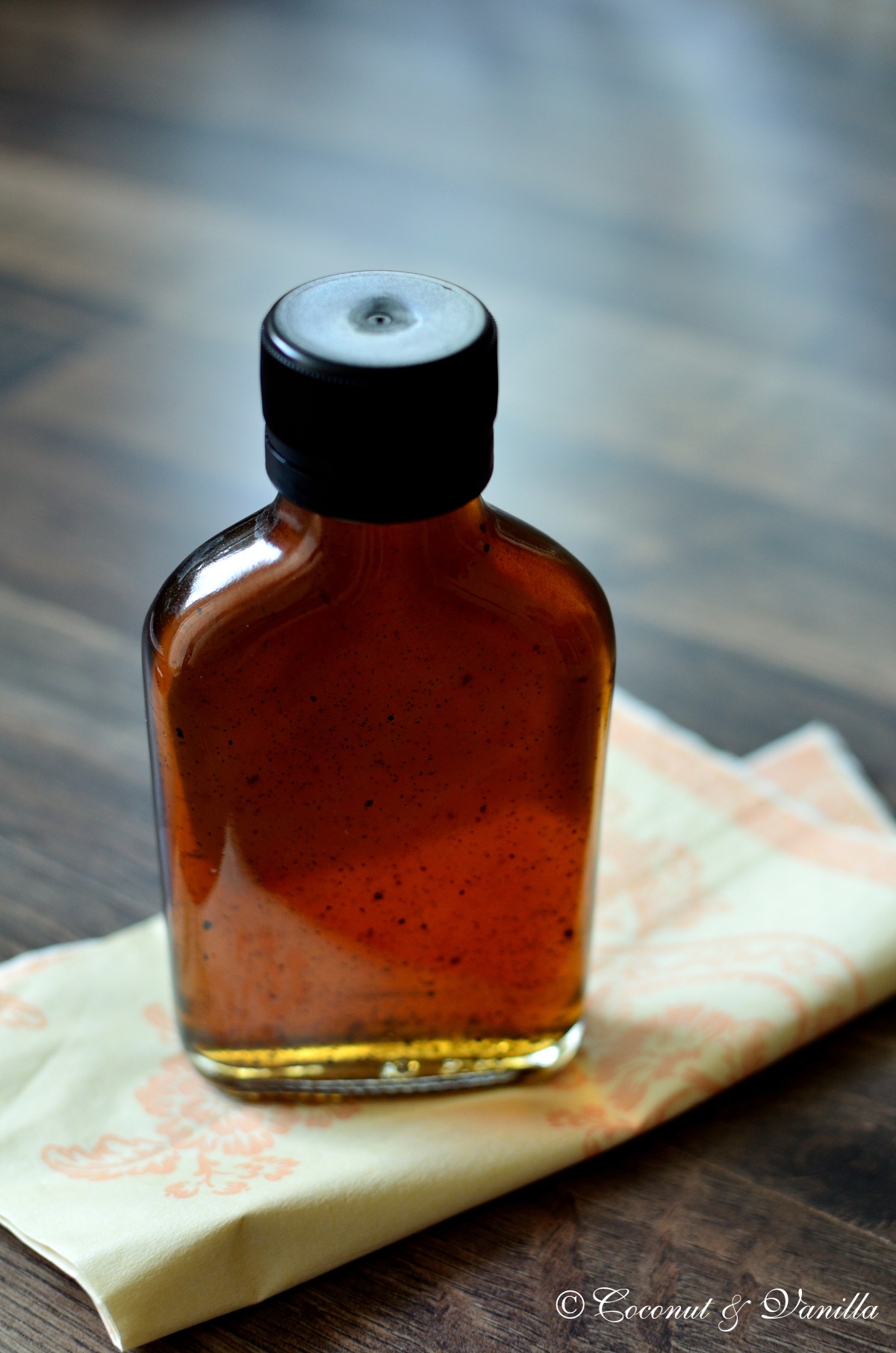
Vor einem Jahr: Vanille-, Zitronen- und Orangenextrakt
Vor zwei Jahren: Toastbrot
Vor drei Jahren: Rhabarber-Streusel-Kuchen
Kaffeelikör
aus Home Made
ergibt 750 ml
Zutaten:
Die Vanilleschoten längs aufschneiden und das Mark herauskratzen.
Zucker, Wasser, Espresso und die Vanilleschoten samt Mark in einem Topf zum Kochen bringen. Etwa eine Stunde zu einem dicken Sirup einkochen. Kurz abkühlen lassen und die Vanilleschoten entfernen.
Den Korn unter den Sirup rühren und in sterilisierte Flaschen füllen.
Sometime it just had to be said: We are huge cocktail lovers and drinkers! We like to sit in a bar for that reason, but beyond happy hour it’s just too expensive for some juice and a shot of booze. So we like to mix them ourselves. Few books about drinks and cocktails are sitting on my shelves between my cookbooks. But for mixing cocktails you need some main ingredients at home, otherwise you will give up soon.
Therefore it’s helpful to have some juices at home, like orange, pineapple, lemon and lime juice. You can also buy bottled lemon and lime juice, they are just alright for mixing and they have a long shelf life in the fridge after opening.
Then you need syrups and liquors. I’m trying to make some of them myself at home, because taking a closer look at the ingredients of many syrups and liquors makes me sick. Most of them have seen the fruit only from the distance and mainly consist of sugar, water, artificial flavours and some stabilizers and preservatives. Mostly, fruit liquors can be easily made at home. I’m making peach and strawberry liquor every year in bulk.
We also like to substitute liquors with syrups and vice versa, since both are sweet and the alcohol content of a liquor doesn’t carry much weight, if you use only 2 cl. Moreover, we don’t follow instructions very closely: if the recipe says raspberry liquor, we take strawberry liquor instead, as we don’t have raspberry and in the end, they are all made from red berries ;).
Last but not least you need some booze, unless you’re preparing an alcohol free cocktail, of course. Vodka, gin, rum, brandy/cognac, tequila, that are my five to go. Don’t buy the cheapest stuff, unless you prefer a headache on the next day. But it also hasn’t to be the most expensive stuff.
A lot of cocktails require triple sec or curaçao (or cointrau or grand marnier). These are liquors with 40 percent alcohol by volume with the taste of bitter oranges and they belong to the family of triple sec/curaçao. You see, if it’s a family, it’s mostly the same. Mostly of course, not 100 %, but if you make yourself free from the exact thing and just enjoy a cocktail, well then yes! Therefore we only own one bottle of grand marnier and that’s it (in Germany you can buy the yellow and cheapest one at A.ldi). If the recipe requires curaçao or triple sec, we just use grand marnier, that’s it. By the way, blue curaçao is the same stuff just with blue artificial colouring. Yuck. As I prefer my cocktails without artificial colours, we replace this also with grand marnier.
If you like creamy cocktails, it makes sense to have some whipping cream (best without carrageenan) at home and some coconut milk.
And then there are these liquors you buy because of the name/brand, but you really don’t know exactly what’s in it. Or that it’s so so easy to make them at home and save a lot of money, too. Kahlúa and Tia Maria, are two of these kind. They are coffee liquors, but the bottle doesn’t say it. And with coffee liquor you can make a lot of delicious cocktails, especially with whipping cream.
So today I’ll give you the recipe for the liquor and soon the recipe for a scrumptious cocktail. Let’s go to the kitchen and prepare some liquor!

One year ago: vanilla, lemon and orange extract
Two years ago: toast bread
Three years ago: rhubarb streusel cake
Coffee Liquor
adapted from Home Made
yields: 750 ml
Ingredients:
Cut the vanilla pods lengthwise and scrape out the seeds.
In a saucepan bring the sugar, water, espresso and vanilla seeds and pods to the boil. Cook for about an hour until you have a thick syrup. Let it cool slightly and remove the vanilla pods.
Stir in the vodka and fill into sterilized bottles.
Pflücksalat, Radicchio, Möhren, Lauch, Brokkoli und Käse (links nach rechts: Teufelskerl, Ziegengouda, Weinkäse, Schäferlaib, Toggenburger)
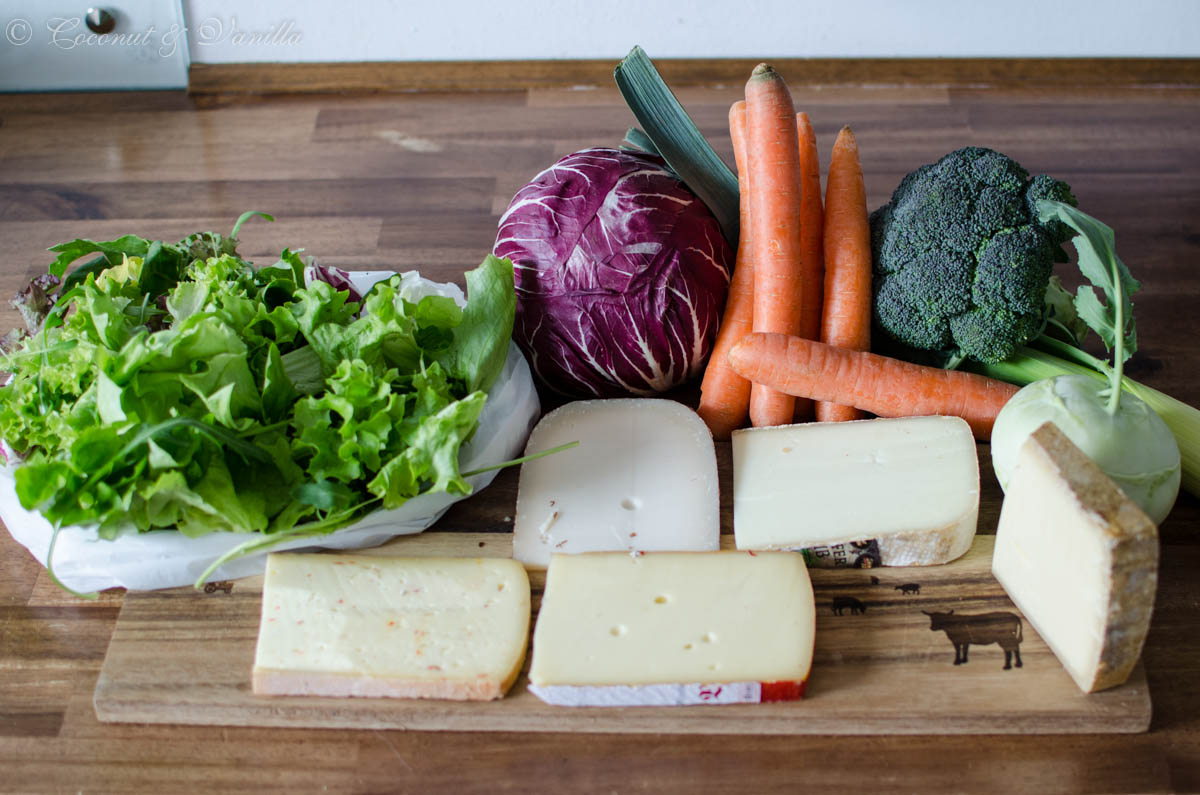
lettuce, radicchio, carrots, leek, brokkoli and cheese (left to right: Teufelskerl, goats cheese gouda, wine cheese, Schäferlaib, Toggenburger)

Dieses Rezept stammt aus dem wundervollen Buch „The Smitten Kitchen Cookbook“ von Deb, die auch auf dem gleichnamigen Blog bloggt.
Es ist diesen Winter zu einem meiner Lieblingsrezepte avanciert, was einem Wunder gleicht, schließlich finde ich Blumenkohl einfach nur zum Davonlaufen! Dieses Pesto ist aber ein Gericht, dass Blumenkohl nicht zu essbar, sondern lecker macht. Eine echte Offenbarung! Hinzu kommt, dass dieses Essen ruckzuck auf dem Tisch steht, nicht viele frische Zutaten benötigt und man Reste auch prima einfrieren kann.
Überhaupt verarbeite ich allerlei Gemüsereste gerne zu Pesto und friere diese dann in kleinen Gläschen oder Gefrierdosen ein. Möhren, Paprika, jegliches Blattgemüse, ich habe schon vieles ausprobiert. So habe ich an faulen oder stressigen Abenden immer ein schnelles Essen parat. Nudeln gehen schließlich immer, oder?
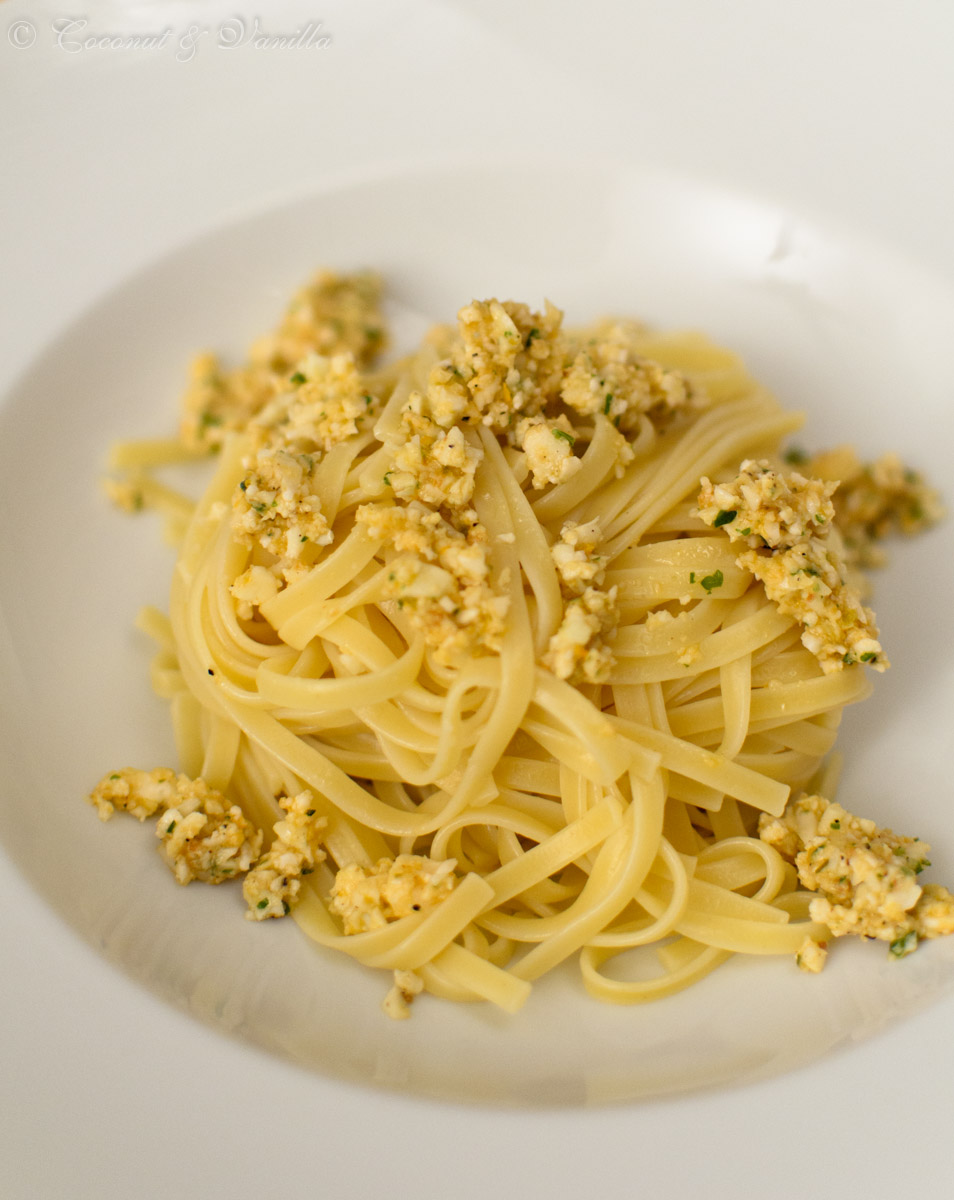
Vor einem Jahr: Eierlikör Cupcakes
Vor zwei Jahren: Rhabarber Muffins
Linguine mit Blumenkohlpesto
nach einem Rezept aus The Smitten Kitchen Cookbook von Deb Perelman
für 4 – 6 Personen
Zutaten:
Wasser aufkochen für die Pasta.
Den Blumenkohl in einem Food Processor / Universalzerkleinerer hacken bis er so klein wie Couscous ist und etwas größer. Am besten auf zweimal machen. In eine Schüssel geben.
Sind die Tomaten in Öl eingelegt abwaschen und klein schneiden.
Knoblauch, Paprikaflocken, Pinienkerne, Parmesan, Tomaten, Kapern und Petersilie im Zerkleinerer hacken bis alles die Größe von Semmelbrösel hat. Wenn sich auf Grund von Öl/Feuchtigkeit alles zu einer zähen Masse verklebt, kann man etwas Blumenkohl dazugeben um es wieder aufzulockern. Die Zutaten zum Blumenkohl in die Schüssel geben. Olivenöl, Essig und etwas Salz dazugeben und verrühren. Mit Salz, Pfeffer und Essig abschmecken.
Die Linguine im kochenden Salzwasser garen bis sie al dente sind. Die Nudeln abgießen und 250 ml Kochwasser zurückbehalten.
Die Nudeln mit dem Pesto und der Hälfte des Kochwasser mischen. Ist das Pesto zu dickflüssig noch etwas Kochwasser dazugeben.
Mit frisch geriebenem Parmesan servieren.
PS: Wer keinen Zerkleinerer hat, kann auch alles mit einem großen Messer klein hacken.
This recipe is from the great book „The Smitten Kitchen Cookbook“ by Deb Perelman.
It evolved into one of my favourite dishes this winter, which is kind of a wonder, since I really dislike cauliflower! But this pesto makes a dish of the cauliflower, which is not just edible, but quite delicious. What a revelation! Furthermore, this dish is on the table in no time, doesn’t need a ton of fresh produce and the over lefts can be frozen easily.
Generally, I like to make pesto of leftover vegetables and freeze it in small glasses or tupperware. Carrots, bell peppers, any leafy greens, I’ve tried already a lot. And on lazy or busy week nights I have dinner ready already. Because we can always eat pasta, right?

One year ago: eggnog cupcakes
Two years ago: rhubarb muffins
Linguine with cauliflower pesto
adapted from The Smitten Kitchen Cookbook by Deb Perelman
yields: 4 – 6 servings
Ingredients:
In a large pot boil water for the pasta.
Chop the cauliflower in a food processor until it has the size of different sized couscous. Better make it in two batches. Pour the cauliflower into a bowl.
If the tomatoes are oil-packed, drain them under water and chop them.
Pulse garlic, pepper flakes, pine nuts, parmesan, tomatoes, capers and parsley in the food processor until it looks like breadcrumbs. If it gums up to a chewy dough because of oil/moisture add some cauliflower to loosen it again. Add everything to the bowl. Add the olive oil, vinegar and salt and stir until combined. Season with salt, pepper and vinegar.
Cook the linguine until al dente. Drain and reserve 250 ml of cooking water.
Toss the pasta with the pesto and half of the reserved cooking water. If the pesto is still too thick add some more water.
Serve with freshly grated parmesan.
Note: If you don’t own a food processor simply chop everything by hand with a large knife.